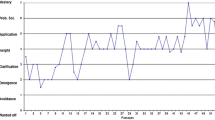Abstract
This paper describes the Two-Track Differentiation Paradigm, an updated therapeutic methodology within psychotherapy. The Two-Track Differentiation Paradigm is based on the assumption that patients habitually regard their problems as one-dimensional and thus tend to become rigid in their attitudes toward these problems. The paradigm suggests a psychotherapeutic process of enriched reframing called Differentiation. This Differentiation between patients’ negative and positive narratives and perceptions offers them more options and frees them to contend with their problems more effectively. Thus, with the Two-Track Differentiation Paradigm, cases of impasse and stuck psychotherapeutic situations are turned into cases of cooperation.
Similar content being viewed by others
References
Beck, A. (1976). Cognitive therapy and the emotional disorders. New York: International Universities Press.
Beck, J. S. (2011). Cognitive behavior therapy: Basics and beyond (2nd ed., pp. 19–20). New York, NY: The Guilford Press.
de Shazer, S. (1988). Clues: Investigating solutions in brief therapy. New York: W.W. Norton.
Descartes, R. (1984). Meditations on first philosophy. In The philosophical writings of René Descartes in 1641 (Vol. 2, pp. 1–62) (J. Cottingham, R. Stoothoff, & D. Murdoch, Trans.). Cambridge: Cambridge University Press.
Efran, J., Lukens, R., & Lukens, M. (1988). Constructivism: What’s in it for you? Family Therapy Networker, 12, 26–35.
Hammond, C. (1990). Handbook of hypnotic suggestions and metaphors. New York: W.W. Norton.
Jaber, E., Trilling, F., & Kelso, E. B. (1997). The circle of change: An approach to difficult clinical interactions. Families, Systems & Health, 15, 163–174.
Kaffman, M. (1981). Monoideism in psychiatry: Theoretical and clinical implications. American Journal of Psychotherapy, 35(2), 235–243.
Kahn, D. (1988). Polarities and unity in human existence, an interdisciplinary perspective. Jerusalem: Carmel Publishers.
Manicavasagar, V., Perichet, T., & Gordon, P. (2012). Cognitive predictors of change in cognitive behaviour therapy and mindfulness-based cognitive therapy for depression. Behavioural and Cognitive Psychotherapy, 40(2), 227–232.
Meyerson, J., & Konichezy, A. (2009). Out-of-illness experience: Hypnotically induced dissociation as a therapeutic resource in treating people with obstinate mental disorders. American Journal of Psychotherapy, 63(2), 133–146.
Minuchin, S., & Fishman, H. C. (1981). Family therapy techniques. Cambridge MA: Harvard University Press.
Navon, S. (2005a). The illness/non-illness treatment model: Psychotherapy for physically ill patients and their families. The American Journal of Family Therapy, 33, 103–116.
Navon, S. (2005b). Listening to Illness/Non-Illness motifs: A case of fibromyalgia. Families Systems & Health, 23, 358–361.
Navon, S. (2014). The Illness/Non-Illness model: Hypnotherapy for physically III patients. American Journal of Clinical Hypnosis, 57(1), 68–79.
Navon, S. (2015). The dual-dialectical conceptualization in psychotherapy. American Journal of Psychotherapy, 69(1), 53–63.
Navon, S. (2016). The dual-dialectical conceptualization: A case of Crohn’s disease. Journal of Psychotherapy Integration, 26(4), 347–352.
Omer, H. (1994). Critical interventions in psychotherapy: From impasse to turning point. New York: W.W. Norton.
Seddon, F. (1996). Aristotle & Lukasiewicz on the principle of contradiction. Ames, IA: Modern Logic.
Watzlawick, P. (1978). The language of change. New York: Basic Books.
Waxman, D. (2005). Don’t just do something, stand there. Families Systems & Health, 23, 362–363.
Author information
Authors and Affiliations
Corresponding author
Ethics declarations
Conflict of interest
The authors declare that they have no conflict of interests.
Rights and permissions
About this article
Cite this article
Navon, S., Meyerson, J. & Lahav, Y. Two-Track Differentiation Paradigm in Psychotherapy. J Contemp Psychother 48, 27–32 (2018). https://doi.org/10.1007/s10879-017-9368-5
Published:
Issue Date:
DOI: https://doi.org/10.1007/s10879-017-9368-5



